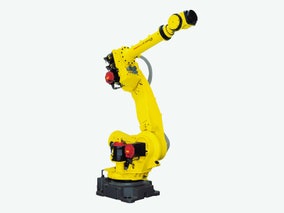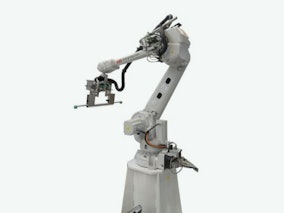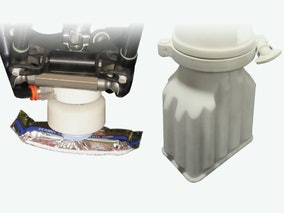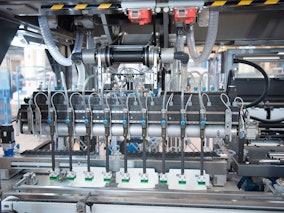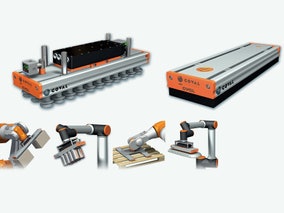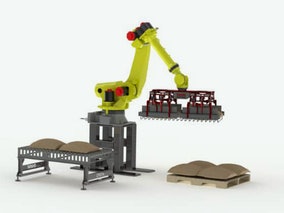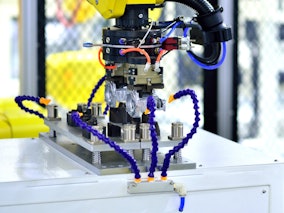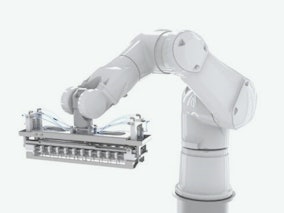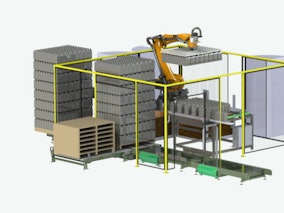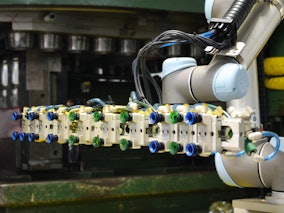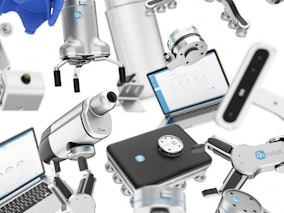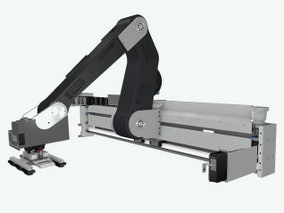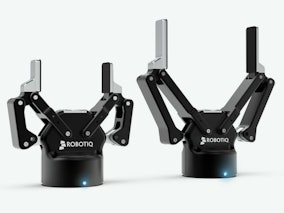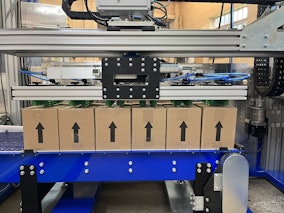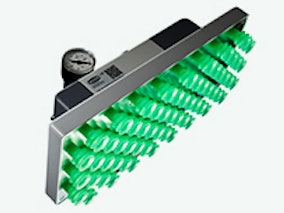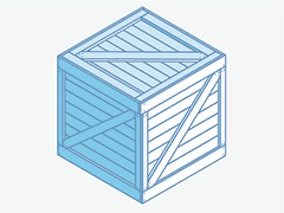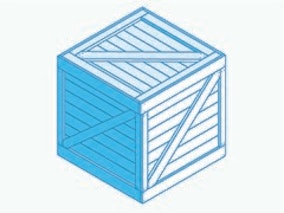Mechanical End-of-Arm Tooling
(17 companies)Mechanically actuated, servo-driven gripper tools affixed to a robotic arm that use force to collect, lift and release items and perform other functions such as assembly.
-

Acieta
RōBEX’s engineering team can design and manufacture any in-plant material handling equipment needed in-house, including custom end-of-arm tooling (EOT) for cobots and robots to perform their tasks. RōBEX is an authorized FANUC integrator that designs and manufactures robotic systems for depalletizing, palletizing, pick-and-place, and case packing and machine tending.
You are currently not logged in -

B&B Packaging Technologies
Tooling for B&B’s Robotic LEAP (Line Extension Automated Packaging) is custom designed for combination bag/sack packing and case and slip sheet manipulation. LEAP is an innovative development to automate the packaging process of bags and pouches into cardboard boxes. With B&B’s simple user interface and software, no special programming skill-set required to properly configure pack patterns.
You are currently not logged in -

BluePrint Automation (BPA)
BluePrint Automation provides 3-D printed end-of-arm tooling for integration into an existing BPA-supplied robotic end-of-line packaging solution, from concept to production floor in hours. 3-D printed end-of-arm tooling allows for a variety of packaged and naked products to be packed on the same line.
You are currently not logged in -

Cavanna Packaging USA, Inc
Cavanna designs, manufactures and tests its own toolings from its CARTESIO robotics division. End- of-arm tooling (EOT) equipment is tested on a wide installed base, and also on 3D simulation, bench testing and reliability trials. EOT equipment is designed for easy changeover and a recipe-driven approach. Smart tags reduce failures and boost vertical start-ups after any changeover.
You are currently not logged in
-

COVAL Vacuum Technology, Inc.
COVAL develops customized, on-demand vacuum gripper solutions for automated applications in various sectors throughout the production chain in packaging, food processing and plastic processing. From components for vacuum automation to complete grippers for robots, COVAL’s products are used in a range of applications from the individual handling of objects to complete end-of-line layer palletization.
You are currently not logged in -

DMM Packaging, Inc.
DMM Packaging offers end of arm tooling (EOT) with a wide array of end effectors to tackle difficult tasks and increase output without increasing labor. Vacuum and mechanical EOT can be included in the double or single wide Almond Palletizer. EOT on this palletizer can stack quickly without interrupting production, running up to 10 cycles/min. The EOT for this palletizing system helps it successfully achieve repeatable precision stacks.
You are currently not logged in -

DT Engineering
Robotic End of Arm Tooling (EOAT) grippers play a vital role in industrial automation, enhancing the versatility and efficiency of robotic systems. DT Engineering grippers are collaborative subassemblies mounted to the end of a robotic arm, enabling the robot to interact and manipulate objects in various applications. EOAT grippers come in diverse designs, including pneumatic, hydraulic, and electric variants, each tailored to accomplish specific tasks in a variety of environments. From industrial assembly to material handling, DT Engineering’s EOAT grippers are indispensable tools, improving productivity and accuracy in today’s automation-driven industries.
You are currently not logged in -

Marchant Schmidt, Inc.
Robotics used in direct food contact applications have special hygienic requirements. Marchant Schmidt specializes in ultra-hygienic designs, from conveyors to custom end-of-arm tooling used in robotic handling operations for cheese and other foods. Marchant Schmidt partners with Staubli Robotics to build end-of-arm tooling with stainless steel instead of aluminum and avoid catch points that could harbor bacteria. Even the routing of cables and hoses is critically important when designing ultra-hygienic end-of-armm tooling.
You are currently not logged in
-

McGinn-Wilkins Automation Inc.
MWA manufactures custom robotic machinery engineered specifically to meet its customers' product demands. MWA's products include end effectors used as tooling for robotic applications in material handling, tote loading and unloading, tray loading, as well as other robotic packaging and palletizing applications.
You are currently not logged in -

ONExia Inc.
ONExia designs and builds custom end-of-arm tooling and grippers for robotic applications that require multiple picks or multi-stage functionality within a single movement.
You are currently not logged in -

OnRobot US Inc
The OnRobot product range features a wide assortment of tools and software for collaborative applications, including electric, vacuum and magnetic grippers, the award-winning Gecko gripping technology, force/torque sensors, tool changers, and more. Highlighted end-of-arm tools on the OnRobot website include the RG6, a 6kg payload robot arm gripper. This flexible collaborative gripper features a built-in Quick Changer and handles up to 150mm strokes. It provides intelligence, fast deployment, easy customization and programming. Other end-of-arm tools from OnRobot include palletizer grippers, soft grippers, electric vacuum grippers, three-fingered grippers, screwdriver tools, and many robotic tool accessories.
You are currently not logged in -

Pester USA Inc.
End-arm-tooling from Pester can handle applications ranging from insertion of pallets with filled plastic trays in depalletizers to pick-up of trays and carpules via robotic tray loading. Arms feature position control via camera, including rejection function.
You are currently not logged in
-

ROBOTIQ
Robotiq supplies end-of-arm grippers complementing its collaborative robots that handle a range of applications from assembly and pick and place to quality testing and palletizing. Featured tooling includes the 2F-85 and 2F-140 Adaptive Grippers, designed for “plug and play” applications on cobots for picking parts of different size and shapes. Grippers help to eliminate changeovers and reduce tooling costs. Other grippers offered by Robotiq include the Hand-E Adaptive Gripper for precision assembly and the 3-Finger Gripper for maximum versatility and flexibility in picking up objects of any shape. Robotiq also offers vacuum grippers, sensing and vision grippers, force torque sensors and other tools for cobots.
You are currently not logged in -

ROI Industries Group, Inc.
ROI offers custom-tailored end-of-arm tooling (EOAT) options that are meant to work jointly with its line of PALLETPOD products. ROI’s EOAT products include custom layer grippers, multi-zone layer grippers, mechanical grippers, vacuum grippers, and other options designed to meet palletizing and other business needs while helping companies maximize profits. Optional tool changers can be added to efficiently use multiple EOATs in a single POD.
You are currently not logged in -

Schmalz Inc.
As small and light corobots with payloads of up to 25 kilograms become increasingly popular with small and medium-sized companies, tailor-made gripper systems can be flexibly adapted to operate doing almost any task. Schmalz offers grippers and vacuum generators for all common cobots and lightweight robots on the market, providing solutions for a wide range of applications. Grippers are designed to integrate easily, and can be used in a wide variety of applications, including depalletizing.
You are currently not logged in -

SMC Corporation of America
SMC produces compact and lightweight automation components for robotics applications and end-of-arm tooling. SMC offers a wide variety of products that can be used for handling work pieces of different shapes and materials. For more information on SMC's end-of-arm tooling, visit the website link below.
You are currently not logged in
Report an Issue
Incorrect/inaccurate categorization? Report inaccuracies or problems »
Related End-of-Arm Tooling searches
More on Mechanical End-of-Arm Tooling
Mechanical end-of-arm tools (EOAT) are essentially servo-driven gripper tools that are affixed to a robotic arm. They use force to collect, lift and release items, and can perform a wide range of other functions such as assembly, welding, and cutting. Unlike pneumatic or hydraulic grippers, which rely on compressed air or fluid to operate, mechanical grippers are powered by electric motors and can be controlled more precisely.
One of the main conveniences of mechanical end-of-arm tools is their flexibility. They can be designed to handle a wide range of objects, from small parts to large components, and can be customized to suit specific applications. For example, some grippers are designed to pick up fragile objects without damaging them, while others are designed to handle heavy loads with ease.
An additional advantage of mechanical end-of-arm tools is their reliability. Unlike pneumatic or hydraulic systems, which can be prone to leaks and other issues, mechanical grippers are less likely to fail due to their simpler design. This makes them ideal for applications where downtime is not an option.
Mechanical end-of-arm tools are also cost-effective compared to other types of grippers. They require less maintenance and are generally less expensive to repair if something goes wrong. Furthermore, they can be retrofitted onto existing robotic systems, allowing companies to upgrade their automation capabilities without having to invest in a whole new system.
When selecting a mechanical EOAT, there are several factors to consider. One of the most important is the type of gripper mechanism. There are several different types of grippers, including parallel, angular and three-jaw, each with its own advantages and disadvantages. For example, parallel grippers are known for their simplicity and versatility, while angular grippers are better suited for handling irregularly shaped objects.
Another factor to consider is the gripping force required for the application. Gripping force is determined by the weight and size of the object being handled, as well as the angle at which it is being picked up. It’s important to choose a gripper with enough force to securely hold the object, but not so much force that it damages it.
Finally, the speed and precision of the gripper should also be determined. Mechanical grippers can be controlled with great precision, allowing for accurate positioning and manipulation of objects. However, they may not be as fast as pneumatic or hydraulic grippers, which can be an issue for applications where speed is a priority.
In conclusion, mechanical end-of-arm tools are an essential component of robotic automation, enabling companies to increase efficiency, reduce labor costs and improve product quality. With their flexibility, reliability and cost-effectiveness, they are a popular choice for many applications. When selecting a mechanical gripper, it is important to consider factors such as the type of gripper mechanism, gripping force, and speed and precision. By choosing the right gripper for the job, companies can optimize their automation capabilities and achieve greater success in their manufacturing operations.
If you’re in the market for mechanical end-of-arm-tooling systems, continue browsing on PMMI’s ProSource directory of vetted and verified suppliers and manufacturers.
